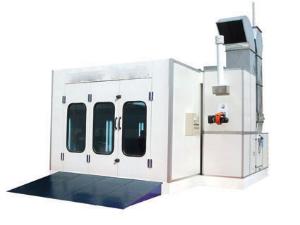Eco-friendly spray booth
Summary of Eco-friendly Spray Booths
An eco-friendly spray booth, as the name implies, is a room where objects are sprayed after being filtered. It is also known as an environmental spray booth. The spray booth provides a dedicated environment for painting operations, meeting requirements such as temperature, humidity, lighting, and air cleanliness. It restricts and treats the paint mist and organic exhaust produced during spraying before discharging it, making it an environmentally friendly painting device.
1) Based on airflow direction, spray booths can be classified into three types:
- Crossflow spray booth: Air flows from one end of the booth to the other. This type has low cost and is easy to install. However, the mist moves along the side of the object being painted, and the mist cannot be removed from around the operator's face, resulting in an unsatisfactory working environment.
- Side down-draft spray booth: Air enters the booth through a filter on the ceiling and exits through the side wall base. This is a mid-priced spray booth. Since the mist stays away from the object and can be removed from around the operator, both the painting effect and the working environment are more ideal.
- Full down-draft spray booth: Represents the most advanced technology currently available. Air enters through the ceiling and is discharged through a pit or basement. This exhaust method results in a cleaner painting process and a safer working environment but comes with high costs and space requirements.
2) Based on heating methods, spray booths can be diesel-powered, electrically heated, steam-heated, infrared, waste oil-powered, etc.
3) Based on paint mist treatment methods, spray booths can be dry-type or wet-type (water treatment). The commonly used spray booth utilizes dry treatment, so the filtration system (mainly primary and secondary filtration cotton) needs regular inspection and replacement. Otherwise, it may affect the quality of painting or even cause fires. With advancements in science and technology, the treatment of excess paint mist has become more advanced. Many high-end cars now use water treatment spray booths, dissolving the excess paint mist in water, significantly improving the method of treating paint mist.
Key points for downdraft spray booths include:
1. Ventilation - Critical for downdraft spray booths operation
2. Filtration - Filters small particles in the air
3. Exhaust - Discharges waste air and allows new air to enter
Spray booths are typically used for spraying and baking paint, thus the most accurate description should be "spray-bake booth". They are widely used in industries such as automobiles, machinery, hardware, furniture, and chemicals for surface spraying and baking of workpieces.
To ensure optimal performance, it is crucial to check the air pressure and maintain a clean filtration system before spraying. Additionally, protective clothing and safety equipment must be worn when operating inside the spray booth. Non-essential personnel should not enter the booth.
Maintenance tips include:
- Clean walls, glass, and floor bases daily
- Clean intake dust filters weekly and check exhaust filters for blockages
- Replace floor dust fiber cotton every 150 hours of operation
- Replace intake dust filters every 300 hours of operation
- Clean water pans monthly and wash diesel filters on burners
- Check motors and bearings quarterly
- Clean the entire spray booth and floor net semi-annually
- Clean the entire heat exchanger annually and replace top cotton every 1200 hours of operation
Choosing the right spray booth not only meets high-level spray requirements but also provides a safe, healthy, bright, and comfortable working environment for painters. Domestic spray booths vary in price from low-end models at $22,000-$60,000 to high-end models at $60,000-$150,000, with various functions. Common types include outdoor rainproof, fuel-powered high-temperature, teaching, large passage, environmental, retractable mobile, pumpless water curtain, infrared, and standard spray booths. Most spray booths have modular structures with auxiliary equipment like fans, burners, lights, plates, filters, control boxes, chambers, lamps, and efficient heat exchangers. Specific configurations and models depend on the factory's planning and projections.
Evaluation:
1 point (Total evaluations: 11 people)
